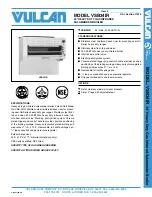
Page 17
The
O
MNI
T
HERM
WARNING
For indoor installations, as an additional measure
of safety, Laars strongly recommends installation of
suitable Carbon Monoxide detectors in the vicinity of
this appliance and in any adjacent occupied spaces.
AVERTISSEMENT
Pour des installations intérieures, Laars recommande
fortement, comme mesure de sécurité supplémentaire,
l’installation de détecteurs de monoxyde de carbone
adaptés dans le voisinage de l’appareil et dans
chacune des pièces habitées adjacentes.
Table 5. Category l Component Examples
Selkirk
Duravent
NovaFlex
B vent
B vent
B vent
90° elbow
*R90-S
*GVL90
45° elbow
*R45-S
*GVL45
Pipe
*R*-S
*GV**
Tee
*RT-S
*GVT
Vertical Termination
*C-S
*GVDC
Boiler adapter
*RDC-S
*GVC
Category I Approved Venting Component Examples
Component
Manufacturer model numbers (abreviated)
* Indicates the remainder of the part number is not shown.
2.B.2 Common Venting Systems
This unit is a Category I fan-assisted when vented
vertically and adhering to all applicable codes. These
units are not allowed to be vented into a common
horizontal Cat III vent system (horizontal discharge
or other configuration for Cat III), unless a properly
sized vent fan is used, and the common vent system
is properly designed by the vent fan manufacturer or a
qualified engineer. When common venting a fan-assisted
unit with other appliances through one shared vertical
duct called a “common vent”, special care must be taken
by the installer to ensure safe operation. In the event that
the common vent is blocked, it is possible, especially
for fan-assisted devices, to vent backwards through
non-operating appliances sharing the vent, allowing
combustion products to infiltrate occupied spaces.
If the
appliances are allowed to operate in this condition,
serious injury or death may occur.
It is for this reason that, in addition to following proper
vent sizing, construction and safety requirements from
WARNING
Operation of appliances with a blocked common vent may
lead to serious injury or death. Safety devices must be
implemented to prevent blocked common vent operation. If
safe operation of all appliances connected to a common vent
cannot be assured, including prevention of spillage of flue
gasses into living spaces, common venting should not be
applied, and appliances should each be vented separately.
AVERTISSEMENT
Le fonctionnement d’appareils connectés à un
évent commun bouché peut provoquer de sérieuses
blessures corporelles ou la mort. Des dispositifs de
sécurité doivent être mis en place pour empêcher
que les appareils soient utilisés avec un évent
commun bouché. Si un fonctionnement sécuritaire de
tous les appareils reliés à un évent commun et si la
prévention des dégagements accidentels de gaz de
combustion dans des zones habitées ne peuvent pas
être assurés, un évent commun ne doit pas être mis
en place et les appareils doivent être munis d’évents
individuels séparés.
2.B Category I Venting
2.B.1 Category I Vent
When vented as a category I appliance, the vent system
must conform to the National Fuel Gas Code (ANSI
Z223.1-Latest Edition) in the U.S., or in Canada, to CSA
B149.1 (latest edition). The vent system must be sized
and installed for a Category I Fan-Assisted Appliance.
If chimney height is greater than 25 feet, or if multiple
units are vented into the same vertical vent, a barometric
damper must be installed on each appliance, such that
the flue draft does not exceed (negative) 0.1” w.c.
If using a power venter for any type of Category I
venting, the draft should be set between (negative) 0.01
and 0.10” w.c.
















































